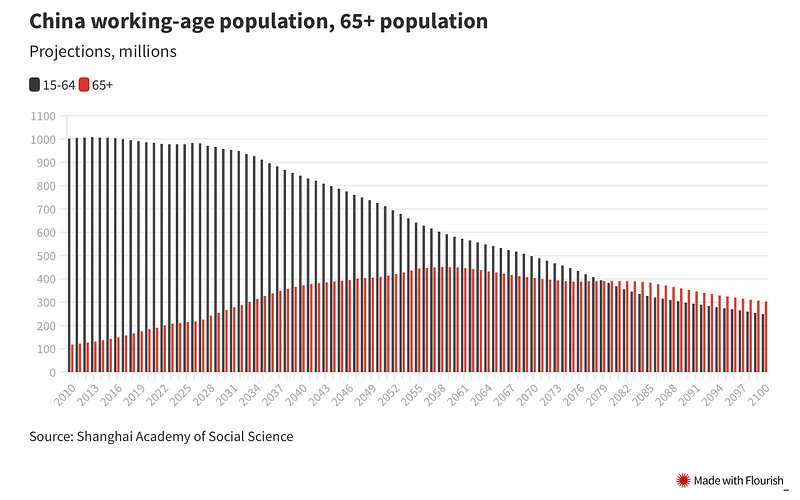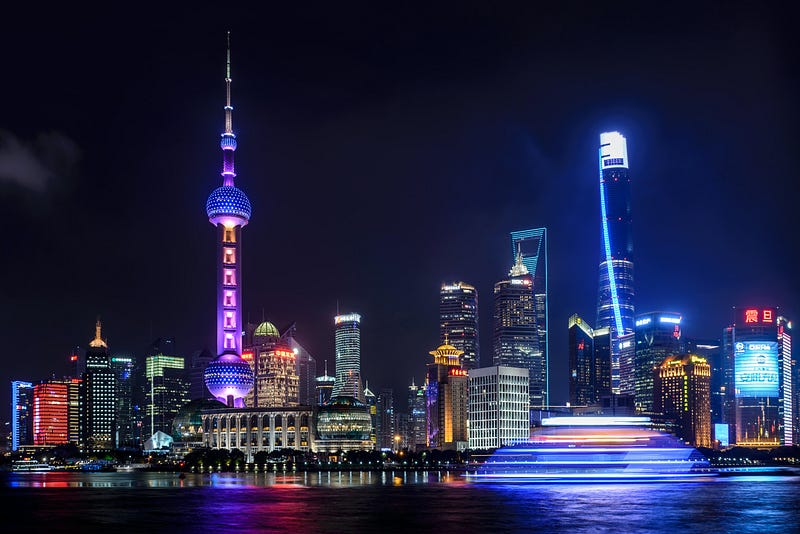Blog
Read my writing about Business, Insolvency, Turnaround, and the Economy.
China’s Demographic Struggles
China’s population will begin to shrink for the first time this year and is expected to fall by almost a billion, to 587 million over the next 80 years.
Further, the China’s working age population peaked in 2014 and from 2079 there are expected to be more elderly people drawing benefits that people working.
Following on from Yesterday’s post about China’s current economic woes, lets look at a longer run challenge, their ageing population.
China’s population will begin to shrink for the first time this year and is expected to fall by almost a billion, to 587 million over the next 80 years.
Further, the China’s working age population peaked in 2014 and from 2079 there are expected to be more elderly people drawing benefits that people working.

This obviously has some dire consequences for China’s long term economic growth and sustainability.
China’s efforts to boost birth rates have thus far been ineffective, with fertility rates continuing to fall. Despite removing the one child policy and providing incentives for people to have children, the fertility rate was only 1.15 children per women last year, well below to the replacement rate of 2.1.
China has also eschewed immigration, the method that most western countries have used to maintain their working age populations as fertility rates fell. In 2017, the last year we have records, China only granted 1,576 permanent residency cards, by comparison, the USA issued over 1.2 million.
If China’s youth continue their aversion to children, I suspect at some point China will be forced into opening the immigration flood gates to keep their economy growing and sustainable.
China’s Economic Woes and the Impact on Australia
After recent economic data showed that both retail spending and industrial production contracted sharply in April, it looks likely that China will miss its annual growth targets this year and is at significant risk of slipping into a recession in late 2022 or early 2023. This would have dire consequences for the Australian economy. China remains our largest export market, consuming almost a third of all exports.

After recent economic data showed that both retail spending and industrial production contracted sharply in April, it looks likely that China will miss its annual growth targets this year and is at significant risk of slipping into a recession in late 2022 or early 2023. This would have dire consequences for the Australian economy. China remains our largest export market, consuming almost a third of all exports.
China’s Current Doldrums
China’s economic data for April was almost universally bad. Retail sales shrank 11.1% year on year (“YoY”), well in excess of the 6.1% markets had predicted. Industrial production also fell (by 2.9% YoY) and manufacturing also declined (by 4.6% YoY). A the same time residential construction starts also fell to 2011 levels. Unemployment is also rising, hitting 6.1% in April, with youth unemployment at a worrying 18.2%.
China has been in a slow economic slide since it introduce curbs on property developers about twelve months ago. But the recent economic doldrums experienced by China are largely a result of the lockdowns impacting major centres like Shanghai, Jiangsu, and Zhejiang. The impact of lockdowns in these cities is most obvious in the daily freight traffic metrics, with all three showing precipitous falls as lockdowns are introduced.
Longer-Term Outlook
China appears to be committed to its zero-COVID strategy for the foreseeable future. There are currently no indications that China is preparing to move to the COVID-normal strategy that many western nations have now adopted. Its booster rollout has been slow, with more than 100 million over 60s still not triple-jabbed, and China has strongly resisted importing and rolling out more effective mRNA vaccines from the West. China also recently backed out of hosting the lucrative Asia Cup tournament in June 2023, an indicator that it expects to remain isolated into next year.
With the highly infectious Omicron variant now circulating in China, it’s highly unlikely that the country will be successful in eliminating the virus. Accordingly, we are going to see a stop-start economy in China, as regions and cities are forced into various levels of rolling lockdown with each successive outbreak. This will continue to have a significant impact on growth and consumer confidence, while continued instability will see supply chains reorientate away from China.
What this means for Australia
The continuation of zero-COVID by China and the resulting economic woes and instability pose a significant threat to Australia’s economy.
A key example is iron ore. There are already signs that the Chinese market for iron ore (Australia’s biggest single export) is significantly overextended. While iron ore spot prices have been historically high during the post-pandemic period, this strength has been largely based on the prospect of significant Chinese Government investment in construction projects. However, these projects are not materialising and will be hard to implement while also pursuing zero-COVID. Current market conditions are unsustainable. While Chinese blast furnaces have been running at near full utilisation, domestic finished steel demand has remained low. Unless steel demand improves significantly, a retreat in iron ore prices is likely, with the associated impacts on Australia’s current account and tax revenue.
There are similar stories for other key Australian exports. Demand for coal and gas from China is likely to weaken as lockdowns reduce demand for energy. We saw a significant drop in energy demand in Shanghai during its extended lockdown and I expect a similar impact from future lockdowns.
With it looking increasingly likely that China will retain a zero-COVID policy until at least 2023, it will be important for Australia to seek out other markets for its exports. There is a significant opportunity for both coal to India and gas to Europe that we should be looking to exploit while working to repair our relationship with China so Australia remains a trade partner and can take maximum advantage when China eventually moves away from zero-COVID and their economy recovers.
